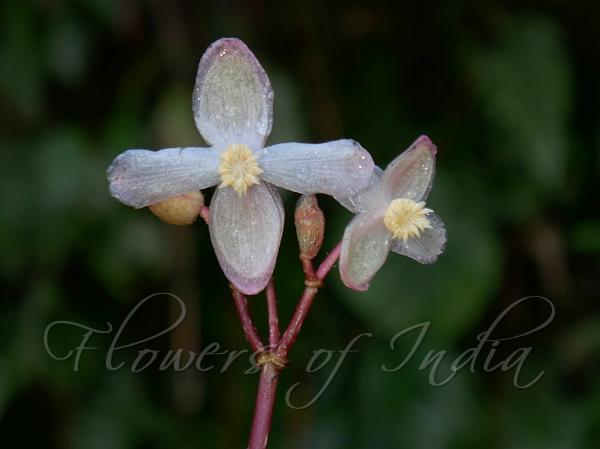|
| Himalayan Begonia |
|

|

| File size | 422395 |
| Original date | 1/18/24 10:40 PM |
| Resolution | 2048 x 1536 |
| Flash | Flash fired |
| Focal length | 42.0mm |
| Exposure time | 1/60s |
| Aperture | 5.6 |
| Focus Distance | |
| Metering Mode | Multi-segment |
| Camera make | Panasonic |
| Camera model | DC-G90 |
| Sensor type | OneChipColorArea |
|
|
|
|
Photo: |
Botanical name: Begonia himalaica Family: Begoniaceae (Begonia family)
Himalayan Begonia is a newly described (2025) species
with male flowers 2-4 cm across, pinkish white; flower-stalk 3-4 cm,
hairless; tepals 4, nearly equal; outer 2, broadly ovate to elliptic,
1.1-2.8 x 1-1.6 cm, hairless, white, with pink towards the tip. Stamens
are about 100, 3-4 mm long; filaments 1-2 mm long. Female flowers are
2-3 across, asymmetric; flower-stalk 1-1.2 cm, hairless, red; tepals 5,
the outer obovate to ovate elliptic to slightly round, 7-13 x 6-8 mm,
the inner, ovate to obovate, 8-11 x 5-6 mm, hairless; styles 2,
greenish yellow, 3-5 mm long; stigma 2, forked and slightly twisted.
Ovary is 1-1.4 cm long, winged, 2-celled. It is similar to Begonia
rockii in having broadly ovate leaves, hairy leaf-stalks, and
bearing inflorescences directly from the rhizome, but differing in
having leaves hairless above and sparsely bristly below (versus
bristlyulous above and bristly below), irregular purplish red patches
(versus white variegation) between the veins, 20-40 cm long leaf-stalk
covered with bristly hairs (versus much shorter leaf-stalk around 3-20
cm, with villose hairs), large 2.0-2.3 cm long hairless boat-shaped
bracts (versus villose ovate-oblong bracts, 0.5-0.8 cm) at the base of
the inflorescence, larger staminate and pistillate (versus smaller)
flowers, extended, pointed (versus flat) anther connectives, and
hairless (versus rough) ovary. Himalayan Begonia is known only from
East Kameng distt., Arunachal Pradesh, at altitudes of about 1000 m.
Flowering: September-December.
| Identification credit: Dipankar Borah | Photographed in Chayang Tajo, Arunachal Pradesh. |
• Is this flower misidentified? If yes,